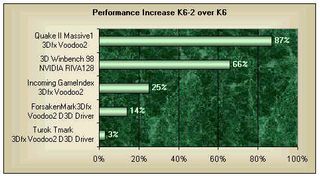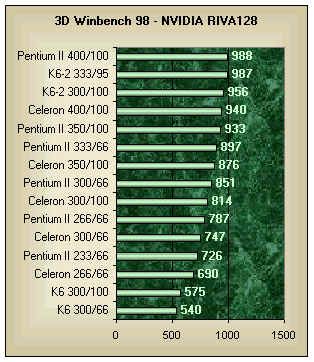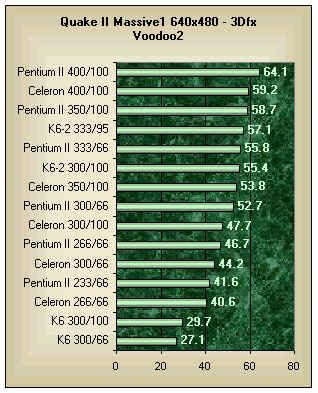AMD's New K6-2 Processor
3D Performance
Evaluating the 3D performance of the K6-2 is not quite as easy as evaluating the office application performance. The reason for this is that the K6-2 requires software that takes advantage of its new instruction set 3DNow!. Thus the performance advantage varies a lot with different games used. The chart below depicts show how different the performance gain of several of today's games can be when generated by 3DNow! . It was accomplished by running these games on a K6 at 300/100 MHz against a K6-2 at 300/100.

Id's Quake II running on a K6-2 and using the new 3Dfx/3DNow! driver is almost double as fast as running on a K6 without 3DNow!, only achieved by optimizing Glide and the mini OpenGL driver, the Quake II engine stayed unchanged. This should be a clear hint on how much performance gain is possible via 3DNow!. 3DWinbench 98 running under Microsoft's latest DirectX 6 beta shows a 66% performance increase through 3DNow! on a NVIDIA RIVA128 card using drivers optimized for 3DNow!. Rage's Incoming was optimized for the K6-2 as well, obviously without the same effort as Quake II, but still showed a 25% increase. Forsaken was not specially optimized for the K6-2, but it still gets a performance gain of 14% out of the DirectX 6. Older games like Turok don't use any fancy DirectX 6 features, thus when running with the K6-2 a similar speed to the K6 CPU was attained.

3D Winbench 98 may not be a very helpful tool when trying to find out about 3D card performance, but it's still pretty useful for CPU benchmarking. The difference of 3D Winbench compared to current 3D games is that ZD doesn't use any own 3D engine, but the engine that's offered by Direct3D, something that isn't done by any current 3D game. DirectX 6 has a 3D engine that is significatnly improved over DirectX 5's 3D engine, thus making any 3D card and any CPU scoring higher results by simply using DirectX 6. 3DNow! is built into DirectX 6, making the K6-2 300/100 and 333/95 score almost as high and no less than a Pentium II 400. However, only games that will use the 3D engine of DirectX 6 will show this amazing performance of the K6-2, unless they will be properly optimized for 3DNow! in the first place. Two facts are very important to Intel:
- Current games do not use the 3D engine offered by Direct3D, because DirectX 5 came with a 3D engine which was too lousy. Instead of this games are using their own 3D engines, only taking advantage of DirectX's raterization features. Future games written specifically for DirectX 6 will possibly use the much improved 3D engine of Direct3D 6.
- The driver of the NVIDIA RIVA128 card running with the K6-2 was specifically optimized for 3DNow!. Drivers of other 3D cards are currently not offering this optimization, thus scoring lower when in comparison to the Pentium II. However, other 3D chip manufacturers may develop drivers optimized for 3DNow! as well soon, which will change the picture.
All in all 3D Winbench 98 shows what is possible. A K6-2 300 could be faster than a Pentium II 400 once 3D software takes full advantage of 3DNow!. All of this perhaps even scaing Intel.

Quake II on a Voodoo2 card, using the new '3Dfx/3DNow! driver is currently the most impressive way of showing how much 3DNow! can kick butt. In the past the K6 didn't have the slightest chance against any of the Intel CPUs when it came down to playing Quake II. Now a K6-2 300 scores an even higher frame rate than the Pentium II 300, which is another scary thing for Intel. The times when every serious Quake II player (like me) had to go for an Intel CPU are definitely over, the K6-2 offers excellent Quake II performance for less money than a Pentium II. Even Thresh is agreeing with me here.
Stay On the Cutting Edge: Get the Tom's Hardware Newsletter
Get Tom's Hardware's best news and in-depth reviews, straight to your inbox.
Most Popular

